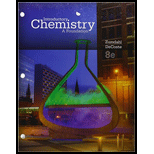
ou seal a container half-filled with water. Which best describes what occurs in the container?
Water evaporates until the air becomes saturated with water vapor; at this point, no more water evaporates.
Water evaporates until the air becomes overly saturated (supersaturated) with water, and most of this water recondenses; this cycle continues until a certain amount of water vapor is present, and then the cycle ceases.
The water does not evaporate because the container sealed.
Water evaporates, and thou water evaporates and recondenses simultaneously and continuously.
The water evaporates until it is eventually all in vapor form.
stify your choice, and for choices you did not pick, explain what is wrong with them.
Interpretation:
If a container is sealed half filled with water then what will happen must be chosen from the options given.
Concept Introduction:
When any liquid is there in a closed container then vapor accumulates above the liquid.
Answer to Problem 1ALQ
Option a) is correct answer.
Explanation of Solution
Reason for correct option:
When the container is half filed with water then there is vacuum above the water surface. Now to compensate the reduced pressure water stars vaporizing and then the vacuum is saturated with water vapor then no more vaporization takes place further.
Reasons for incorrect options:
Option b) is incorrect as over saturation will not arise. After the air is saturated no more further evaporation takes place.
Option c) is incorrect as it is stating that water will not evaporate due to sealed container.
Option d) is incorrect as it is stating that water evaporates and condenses simultaneously and continuously but it’s not stating about saturation.
Option e) is incorrect as it’s stating that whole water will be converted to vapor which is not possible due to water and water vapor equilibrium.
Want to see more full solutions like this?
Chapter 14 Solutions
Bundle: Introductory Chemistry: A Foundation, 8th + OWLv2 6-Months Printed Access Card
- What are intermolecular forces? How do they differ from intramolecular forces? What are dipole-dipole forces? How do typical dipole-dipole forces differ from hydrogen bonding interactions? In what ways are they similar? What are London dispersion forces? How do typical London dispersion forces differ from dipole-dipole forces? In what ways are they similar? Describe the relationship between molecular size and strength of London dispersion forces. Place the major types of intermolecular forces in order of increasing strength. Is there some overlap? That is, can the strongest London dispersion forces be greater than some dipole-dipole forces? Give an example of such an instance.arrow_forwardWhat term is used to describe a substance that readily evaporates at room temperature because of a high vapor pressure?arrow_forwardIdentify two common observations indicating some liquids have sufficient vapor pressures to noticeably evaporate?arrow_forward
- On a particular summer day, the temperature is 30.0C and the relative humidity is 80.0% (which means that the partial pressure of water vapor in the ambient air is 80.0% of the equilibrium vapor pressure of water). A sample of this air is placed in a 1.00-L flask, which is then closed and cooled to 5.0C. What is the mass (in grams) of water that still exists as vapor in the flask? How much liquid water (in grams) condenses out?arrow_forwardConsider the following data for xenon: Triple point: 121C, 280 torr Normal melting point: 112C Normal boiling point: 107C Which is more dense, Xe(s) or Xe(l)? How do the melting point and boiling point of xenon depend on pressure?arrow_forward
 Introductory Chemistry: A FoundationChemistryISBN:9781337399425Author:Steven S. Zumdahl, Donald J. DeCostePublisher:Cengage Learning
Introductory Chemistry: A FoundationChemistryISBN:9781337399425Author:Steven S. Zumdahl, Donald J. DeCostePublisher:Cengage Learning Chemistry: Principles and PracticeChemistryISBN:9780534420123Author:Daniel L. Reger, Scott R. Goode, David W. Ball, Edward MercerPublisher:Cengage Learning
Chemistry: Principles and PracticeChemistryISBN:9780534420123Author:Daniel L. Reger, Scott R. Goode, David W. Ball, Edward MercerPublisher:Cengage Learning General Chemistry - Standalone book (MindTap Cour...ChemistryISBN:9781305580343Author:Steven D. Gammon, Ebbing, Darrell Ebbing, Steven D., Darrell; Gammon, Darrell Ebbing; Steven D. Gammon, Darrell D.; Gammon, Ebbing; Steven D. Gammon; DarrellPublisher:Cengage Learning
General Chemistry - Standalone book (MindTap Cour...ChemistryISBN:9781305580343Author:Steven D. Gammon, Ebbing, Darrell Ebbing, Steven D., Darrell; Gammon, Darrell Ebbing; Steven D. Gammon, Darrell D.; Gammon, Ebbing; Steven D. Gammon; DarrellPublisher:Cengage Learning Chemistry: The Molecular ScienceChemistryISBN:9781285199047Author:John W. Moore, Conrad L. StanitskiPublisher:Cengage Learning
Chemistry: The Molecular ScienceChemistryISBN:9781285199047Author:John W. Moore, Conrad L. StanitskiPublisher:Cengage Learning Chemistry: An Atoms First ApproachChemistryISBN:9781305079243Author:Steven S. Zumdahl, Susan A. ZumdahlPublisher:Cengage Learning
Chemistry: An Atoms First ApproachChemistryISBN:9781305079243Author:Steven S. Zumdahl, Susan A. ZumdahlPublisher:Cengage Learning Introductory Chemistry: An Active Learning Approa...ChemistryISBN:9781305079250Author:Mark S. Cracolice, Ed PetersPublisher:Cengage Learning
Introductory Chemistry: An Active Learning Approa...ChemistryISBN:9781305079250Author:Mark S. Cracolice, Ed PetersPublisher:Cengage Learning





